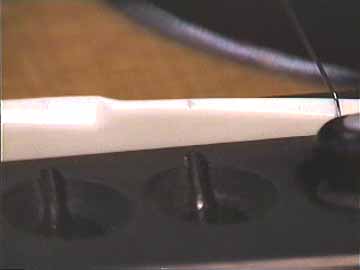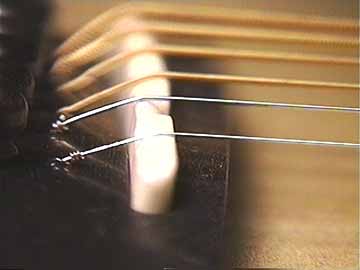Page 1 of 2
The skinny ones go first. . .
Reducing String Breakage at the Saddle
© Frank Ford, 5/14/98; Photos by FF, 5/12/98
If you break lots of strings, you play too hard.
I hope that's fairly obvious. When you hit a string, it bends more at the saddle
or bridge than anywhere else. After all, the other end is a long way from your pick.
Enough bending and flexing, and the string fatigues and breaks.
People who play very lightly don't break strings.
Some heavy handed players break a string every night, and it doesn't seem to bother
them, but most of us get pretty annoyed when a string breaks.
If you pick really hard right next to the bridge you'll be more likely to break strings
than if you play over the soundhole. It's a simple matter of how much you bend the
string at the saddle when you hit it.
On a steel string guitar the G string is usually the first to go because its core
is the thinnest and most fragile. Next, the high E, for the same reason.
If you break the low E exclusively, chances are you're taking a great big windup
and coming at it from a distance. You can't do that with the other strings because
they protect each other from your blows.
If you break lots of strings at the tuning post, you should check to see if the string
is binding as it passes over the nut. It takes extra force to pull a string up to
pitch if it doesn't glide over the nut smoothly.
If you play a lot in alternate tunings, you may break lots of strings at the tuning
post from ordinary fatigue. I have no help for you on that. . .
So, the question is, "How can you reduce string breakage if
you play hard."
Here are some ideas. . .
You know those little nicks you see in the saddle when you change strings?

Well, they can pin the string in position so it can't roll sideways microscopically
when you hit it. With the string pinned in this way it will fatigue and break more
quickly. The problem is that the saddle always gets these little nicks.
To reduce string breakage, I'll smooth out the top of the saddle to remove the nicks
so the string can move around just a little. The nicks will return pretty soon, so
it's a temporary fix, depending on the toughness of the saddle.
I prefer to use the hardest bone I can find for saddles because bone seems to resist
these nicks better that most other materials. The synthetics (Micarta, Corian and
"graphite-epoxy" for example) develop the nicks quite easily.
The angle of the string over the saddle has a big influence on string breakage. Take
this one for example:

Here the string dives almost straight down into the bridge, and passes over a sharp
saddle to form a rather acute angle which is much more likely to cause fatigue and
breakage. This is the saddle that will break the most strings.
(I'm showing the bass strings in some of these photos because they're easier to
photograph.)
A more gentle angle will result in a string that is less likely
to break:

Here the angle is sharper, but look how the string passes over the saddle:

The string is supported through its entire path across the saddle so that the exit
angle toward the neck is really quite gentle. With this kind of support the string
will not make such deep nicks in the saddle. This saddle is an ideal one for reducing
string breakage.
Many years ago a friend of ours who was a monster Bluegrass player decided to
invent the perfect bridge that would completely eliminate string breakage. He made
little bone ramps to replace the saddle. As the strings emerged from the bridge,
they passed over the ramps making a smooth tangential transition toward the neck.
No matter how abusively he hit the strings he was unable to break them!
The unfortunate side effect was that this bridge arrangement destroyed much of the
high and midrange response of a truly great Martin D-18.
OK, OK, I hear you. You're asking, "That's all fine, but what about compensated
saddles, don't they have to be sharp on top?"
Yes and no.
Here's an ideal compensated saddle:

Notice that it's set so that the strings all bear on the front edge ramping up nicely
toward the neck. All, that is, except the nasty B string. It's sitting right on the
point of the saddle and there's no way to change its position True, but it's a really
strong string that hardly ever breaks anyway, so I'm for having it that way as the
best compromise.
More
1
2
Back to Index Page